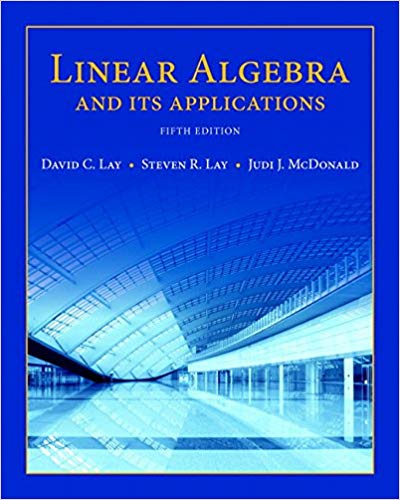
Linear Algebra and Its Applications, 5th Edition
Authors: David C. Lay, Steven R. Lay, Judi J. McDonald
ISBN-13: 978-0321982384
We have solutions for your book!
See our solution for Question 27E from Chapter 4.5 from Lay's Linear Algebra and Its Applications, 5th Edition.
Problem 27E
Chapter:
Problem:
Explain why the space of all polynomials is an infinite-dimensional space.
Step-by-Step Solution
Given Information
We have to explain that why the space P of all polynomials is an infinite dimensional space.
Step-1:
Let the polynomial $P_2$ is gien by: \[ P _ { 2 } = a _ { o } + a _ { 1 } t + a _ { 2 } t ^ { 2 } \] The standard basis is: $\left\{ 1 , t , t ^ { 2 } \right\}$. Thus $P_2=3$
Step-2:
Consider the polynomial $P_n$ given by: \[ P _ { n } = a _ { 0 } + a _ { 1 } t + a _ { 2 } t ^ { 2 } + \ldots \ldots + a _ { n } t ^ { n } \] The standard basis for $P_n$ is: $\left\{ 1 , t , t ^ { 2 } , \ldots \ldots , t ^ { n } \right\}$ hence the dimension is $n+1$.
The space P of all polynomials generates polynomials of any degree $n$, however large the n may be: Therefore,
he space P of all polynomials is an infinite dimensional space.
We have to explain that why the space P of all polynomials is an infinite dimensional space.
Step-1:
Let the polynomial $P_2$ is gien by: \[ P _ { 2 } = a _ { o } + a _ { 1 } t + a _ { 2 } t ^ { 2 } \] The standard basis is: $\left\{ 1 , t , t ^ { 2 } \right\}$. Thus $P_2=3$
Step-2:
Consider the polynomial $P_n$ given by: \[ P _ { n } = a _ { 0 } + a _ { 1 } t + a _ { 2 } t ^ { 2 } + \ldots \ldots + a _ { n } t ^ { n } \] The standard basis for $P_n$ is: $\left\{ 1 , t , t ^ { 2 } , \ldots \ldots , t ^ { n } \right\}$ hence the dimension is $n+1$.
The space P of all polynomials generates polynomials of any degree $n$, however large the n may be: Therefore,
he space P of all polynomials is an infinite dimensional space.